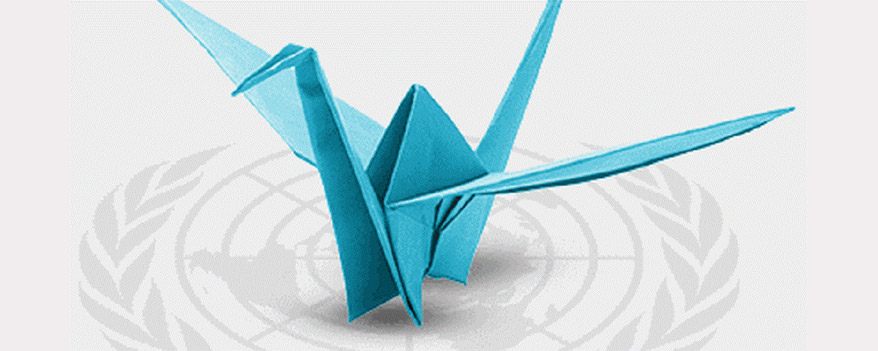Event organized by: UNFOLD ZERO, Basel Peace Office, Parliamentarians for Nuclear Non-Proliferation and Disarmament, The Right Livelihood Foundation, World Future Council, Abolition 2000 Youth Network and Youth Fusion.
On 24 January 1946, the United Nations adopted its very first resolution. It was approved by consensus and established the UN goal of the elimination of nuclear weapons and other Weapons of Mass Destruction (WMD). In commemoration of the 75th anniversary of the resolution, UNFOLD ZERO, together with a wide range of disarmament and peace actors, organised an event on January 25, 2021 to celebrate and highlight the important steps taken by the UN to achieve that goal.
The commemoration event was planned to coincide with four essential happenings in the disarmament field: the entry into force of the Treaty on the Prohibition of Nuclear Weapons (TPNW); the opening of the 2021 session of the UN Conference on Disarmament; the launching of the 2021 position of the Bulletin of Atomic Scientists’ Doomsday Clock – still at 100 seconds to midnight – indicating the threat to humanity from nuclear weapons and climate change; and lastly, the inauguration of a new US President setting the scene for renewed leadership on nuclear disarmament.
The event was moderated by Mr Alyn Ware (Global Coordinator of PNND, Director of the World Future Council Peace and Disarmament Program, and a 2009 Right Livelihood Laureate), and featured the presentations of five speakers as well as a Q&A. The speakers included high-level UN disarmament experts along with civil society leaders active in the peace, disarmament and sustainable development fields. The event concluded with a rich and engaging discussion where the speakers answered a range of comprehensive questions from the audience.
More than 200 civil society representatives, legislators, youth activists and engaged individuals participated in the event, tuning in from across six continents and contributing to a truly global commemoration of UNGA Res 1(1), as well as a celebration of the UN as a central vehicle for facilitating nuclear disarmament. All in all, the event served as a forceful reminder to civil society and policymakers worldwide that the time is now to act against our continued reliance on nuclear weapons globally.
Enjoy the full event, spanning 1 hour and 30 minutes, on our youtube or facebook. For those who would like a reading version, this is for you.
Session 1: Speakers
First to present was Her Excellency Ms Tatiana Valovaya, long time diplomat and current Director-General of the UN Office at Geneva and Secretary-General of the Conference on Disarmament (CD). For more than 35 years, Ms Valovaya has constituted a force to be reckoned with in national and international policymaking on issues ranging from economics to diplomacy and peace and disarmament. In her remarks, she raised the continued threat posed by nuclear weapons 75 years after the UN’s first ever resolution and stressed the need of inclusive multilateral cooperation to agree on near-term practical steps in nuclear disarmament.
Apart from promoting the Non-Proliferation Treaty Review Conference scheduled in August 2021, and celebrating the entry-into-force of the TPNW, Ms Valovaya raised the UN Conference on Disarmament as one of many UN avenues to promote nuclear abolition. She cautioned, however, against the demise of multilateral agreements across recent decades and called on UN Member States to again strengthen and advance the multilateralism that first birthed the United Nations in the aftermaths of WWII. Importantly, Ms Valovaya also highlighted the central role played by civil society and youth networks today in creating and sustaining progressive international policies holding governments accountable for their nuclear disarmament promises.
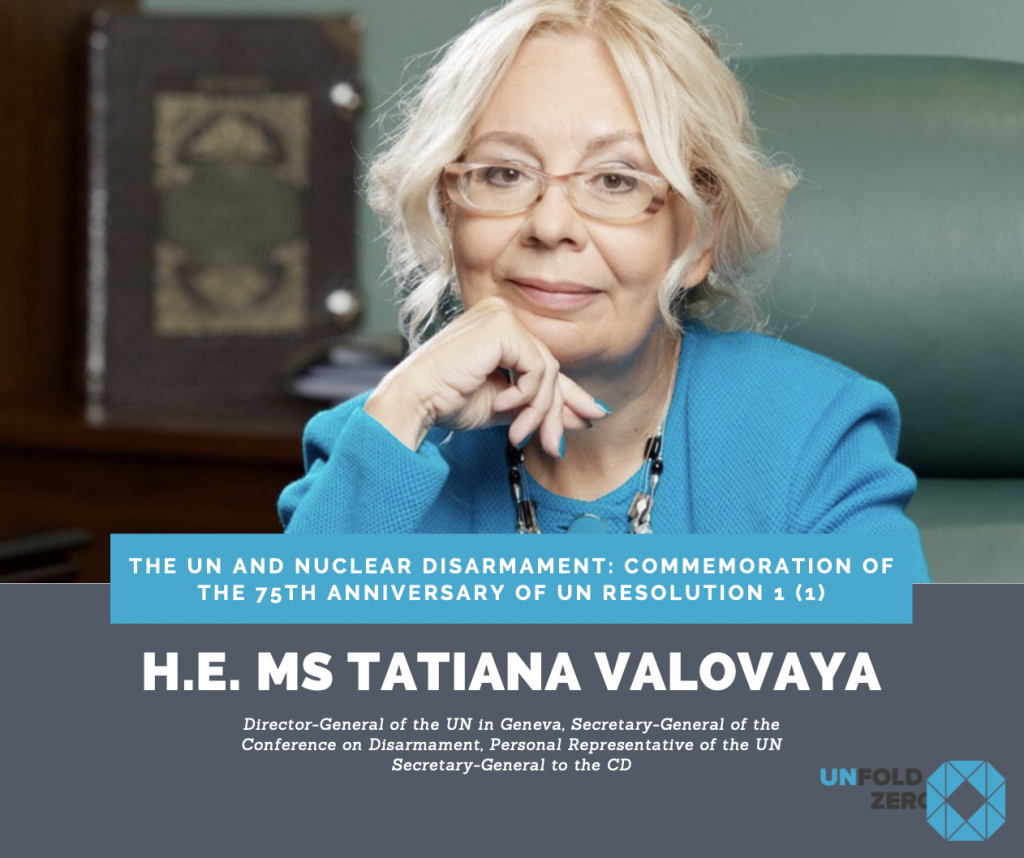
“As the Secretary General of the [UN Disarmament] Conference, I urge Member States to overcome their differences and start without delay a meaningful dialogue that addresses the key substantive issues on which States must focus to make progress, including on nuclear disarmament. What has been missing in that Conference is neither the substantive knowledge of its members, nor worthy subject matters, but rather, the political will to build on them. … The need to narrow divergences and rebuild mutual trust has never been greater.”
The event’s second speaker was Honorable Ms Maria Fernanda Espinosa (Ecuador), President of the 73rd UN General Assembly (2018-2019), World Future Council Member and, amongst many other titles, former Ecuadorian Minister of both Foreign Affairs and Defence. Ms Espinosa has over two decades worth of experience in the diverse fields of politics, civil society action, human rights and gender equality, multilateral cooperation and international negotiations on peace, security, disarmament and climate change.
By painting the grim picture of the only existing examples of the devastation that results from using nuclear weapons – unimaginable to most of us – Ms Espinosa highlighted the importance of remembering and learning from the lessons of history. She drew attention to the fact that the threat of nuclear war is as present today as in the time of the adoption of UNGA Res 1(1). “The situation today is even more dire given that humanity is also facing a new immediate existential threat brought about by a human caused climate change. And to that, we must add the need to recover from the Covid-19 pandemic catastrophe.”
Ms Espinosa further declared that the premises on which nuclear deterrence as a global security stability mechanism is based, have proved to be entirely false. “Since the beginning of their atomic programs, nuclear armed states have constantly engaged in nuclear arms races, thus increasing the risk of bringing about a nuclear confrontation which … would wipe out humanity off the face of the earth.” Ms Espinosa pointed out that it is now clearer than ever before that nuclear weapons are useless in responding to humanity’s actual security needs. Their production and maintenance use up enormous human and financial resources that should be directed towards building back better from the pandemic, protecting the environment and achieving the Sustainable Development Goals.
True to her wide ranging background, Ms Espinosa thus made evident the central role of nuclear disarmament in allowing for progress in the related fields of international peace and security, climate action and sustainability – including the advancement of women’s and children’s rights.
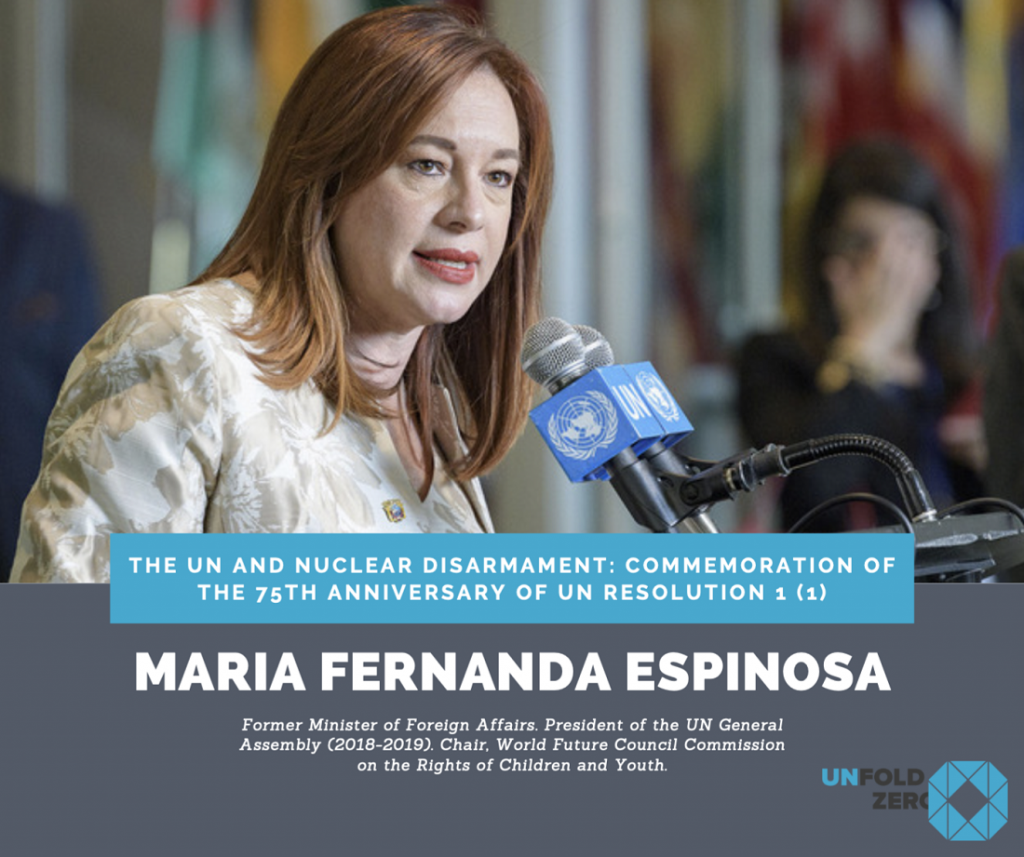
“I believe that the debate we are having here today and the global appeals that are being presented, are really crucial for building the political momentum in the movement towards a world free of nuclear weapons. … The world must commit to the elimination of nuclear weapons by 2045. … For that, I think we need to take seriously the implementation of the UN Disarmament Agenda … enforce the NPT and show true political commitment at the Review Conference this year – and, of course, to make the historic Nuclear Weapons Ban Treaty a reality on the ground.”
Next up to present was Dr Randy Rydell (United States), Executive Adviser of Mayors for Peace and a former senior political affairs officer at the UN Office of Disarmament Affairs. Dr Rydell comes from a broad background of disarmament engagement and arms control policy through government, academia, civil society and think tanks.
He started off his presentation by recalling UNGA Res 1(1) as “a milestone in humanity’s long pursuit of security through disarmament”, further drawing our attention to the fact that taboos against the use of indiscriminate weapons have existed for thousands of years. Within the UN’s first year of existence, it had established the cornerstones for its disarmament and arms control policies for decades to come. It is thus on this rich history of disarmament attempts, we stand today – attempts that must not be forgotten, and require our continued unfaltering energy in advancing and realising their promises for the sake of future generations.
“We have witnessed over the years, the creation of five regional nuclear weapon free zones, widespread and growing recognition of the catastrophic humanitarian consequences of using nuclear weapons, a moratorium on nuclear tests pending a global legal ban, deep cuts in deployments of strategic US and Russian nuclear arsenals, the closure of nuclear test sites and facilities for the production of fissile nuclear material for weapons … the entry-into-force of the Treaty of the Prohibition of Nuclear Weapons … and signs that increasing numbers of young people are on board for disarmament.”
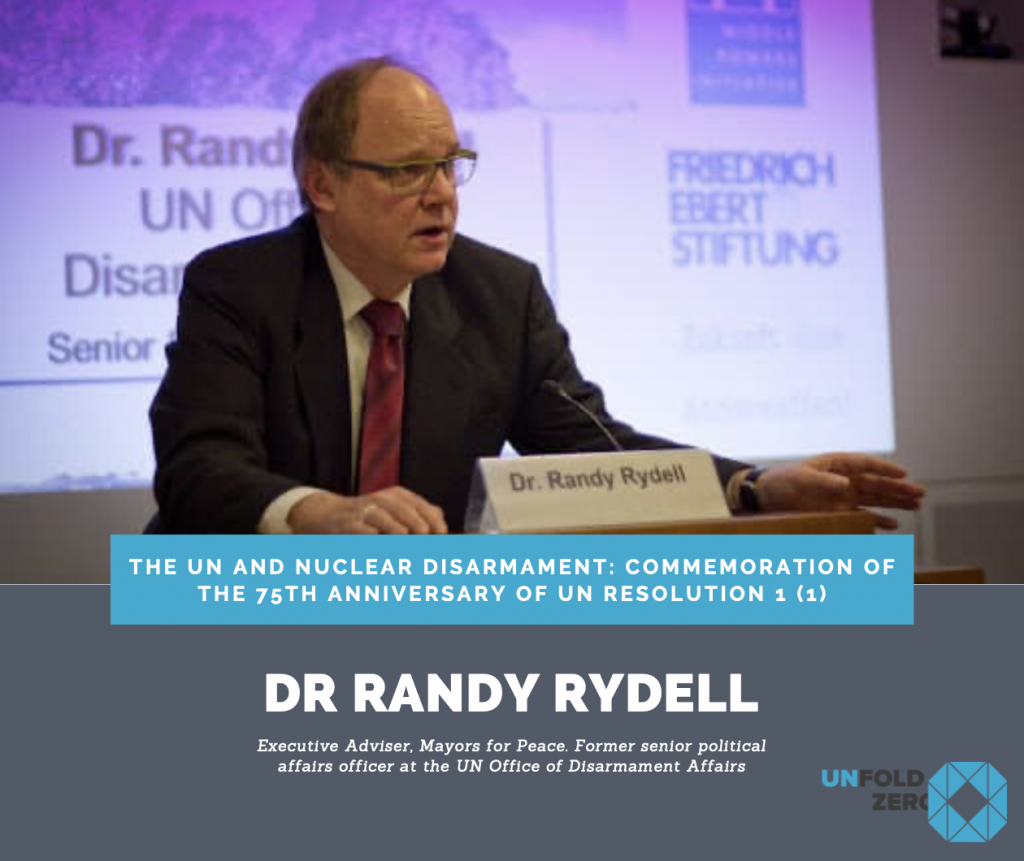
Despite this progress, Dr Rydell cautioned that many a challenge still lies ahead. At the heart of these challenges are the fact that if States had made sure to implement the mandates and visions of the UN’s first ever Resolutions, not only disarmament but war itself could have been overcome. The lack of congruence between the noble goals of UN Resolutions and Member States domestic and international policies and priorities, Dr Rydell noted, remains one of the largest obstacles to the actual advancement of disarmament, including through initiatives that have existed for decades. “Yet, the legacy of Resolutions 1 and 41 lives on today and continues to inspire new initiatives for moving forward. … On January 20th military officers carried two nuclear footballs … containing the means available to a departing and an arriving US President for launching nuclear weapons.”
“Today, let us imagine a time when officers will accompany presidents around the world with a disarmament football, containing all the tools needed for eliminating nuclear weapons globally. … These would include [tools such as] drafts of treaties, initiatives to improve compliance, … inspirational speeches for national and global audiences, … plans to expand engagement with civil society, ambitious programs for disarmament education [and] ways to guarantee the irreversibility of disarmament, … and, of course, the UN Charter. This disarmament football contains all the tools we need to make our times, the best of times.”
First out among the event’s two youth leaders, was Ms Kehkashan Basu (Canada/United Arab Emirates), Member of the World Future Council, founder of Green Hope Foundation, a UN Human Rights Champion and Winner of the 2016 International Children’s Peace Prize as well as the First-Ever Voices Youth Gorbachev-Schultz Legacy Award for Nuclear Disarmament.
Ms Basu has been active as a youth speaker and leader impacting global policy on children’s rights, peace and disarmament, climate justice and gender equality since the age of 8. Combining civil society engagement with advancing her goals through various UN branches, Ms Basu has shown the way for so many, youths and otherwise, in promoting the global work for peace and disarmament and their mutual dependency on the advancement of climate justice and the Sustainable Development Goals.
She began her presentation with again taking us back to the adoption of UNGA Res 1(1), but only to point out that, here we are “seven and a half decades later – that is more than the average lifetime – yet the threat of nuclear weapons, much like this proverbial sword of Damocles, continues to hang by a thin thread over humanity. A thread so fragile that it can snap at the press of a button and literally push humanity and also all other life forms on our planet, irrevocably towards extinction. The glaring irony of it all befuddles me, more so because our policy makers and leaders who call for our votes ostensibly to make our lives better for us, can’t seem toagree upon obliterating this human created threat that’s far more potent and lethal than any virus known to us.”
Ms Basu highlighted the bullying methods adopted by “nuclear club” states, such as the United States, urging us all to identify the ulterior motive underlying the persistence of global nuclear competition. Likening the recent US attempts to scare States Parties to the TPNW to withdraw their ratification instruments, to a real life David and Goliath situation, Ms Basu then pressed the fact that “for truth and good to prevail, we have to make David larger and stronger than Goliath. That can only happen if we are able to deal with national security and patriotism away from nuclear weapons, and lay bare the real agenda of profit and megalomania that drives this insane race.”
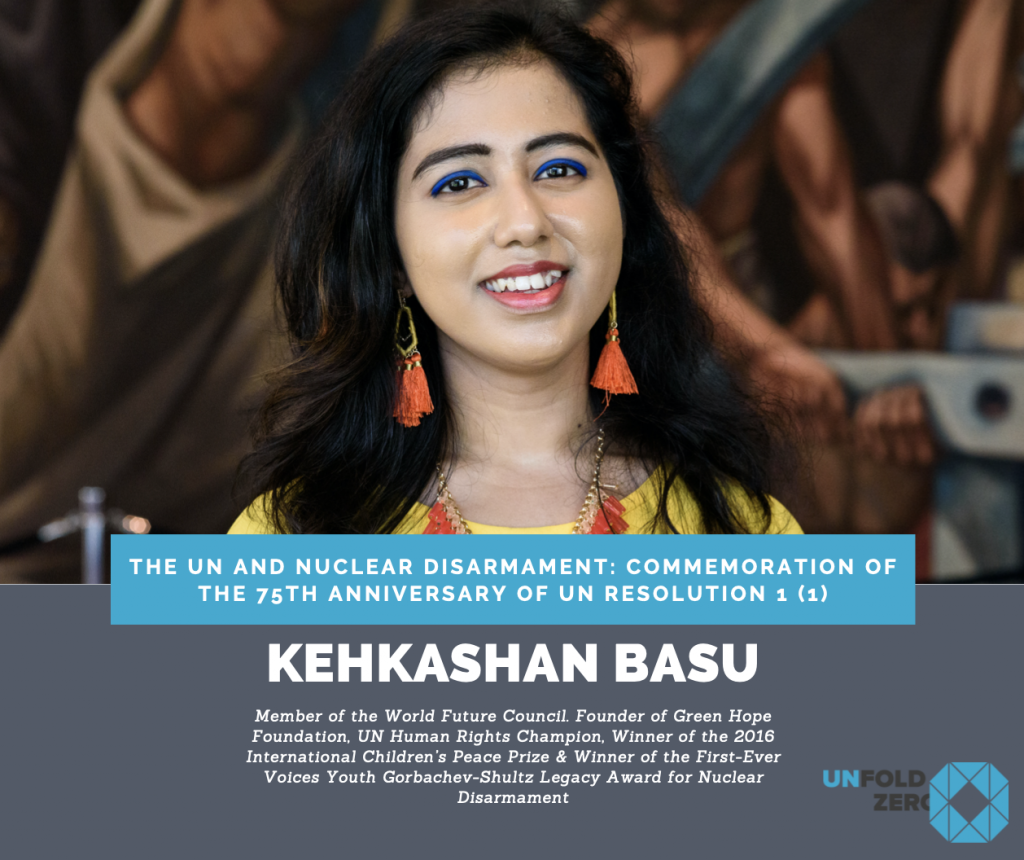
Ms Basu then made a powerful and immediate connection between, on the one hand, sustainable development and human security – including our ability to alleviate poverty, reverse climate change, combat gender based violence, effectively manage the spread of diseases, and better the conditions for migrants and refugees across the world – and on the other, states’ continued prioritisation of instead developing more and greater vehicles of mass annihilation. Little is required to see that something is terribly amiss in this chain of prioritisation. Importantly, Ms Basu highlighted the colonial nature of today’s global nuclear regimes: “I call it nuclear colonialism, because it is a system of domination through which governments and corporations disproportionately target and devastate indigenous peoples and their lands to maintain the nuclear production process.”
“Our focus should not just be on the end product of nuclear weapons, but on the elimination of the entire process, from mining, production, and waste-siting. Because at each step of this process there is injustice. … How can we make David stronger and larger than Goliath? The root to that lies in education. Disarmament education holds the key to removing the mists of secrecy and misinformation that allow these nations to justify their nuclear agenda to the masses.”
Ms Vanda Proskova (Czech Republic) concluded the event’s presentations, who, apart from co-convening Youth Fusion and participating as a Global civil society youth speaker for the 2020 UN High Level Meeting on the Total Elimination of Nuclear Weapons, is also the Vice-Chair of PragueVision Institute for Sustainable Security as well as a co-moderator of #WeThePeoples2020 (read about and sign their appeal here). A current graduate student of International Law, Ms Proskova has a rich history of domestic and international civil society campaigning and project coordination, UN disarmament engagement and think tank advocacy for the implementation of sustainable security policy.
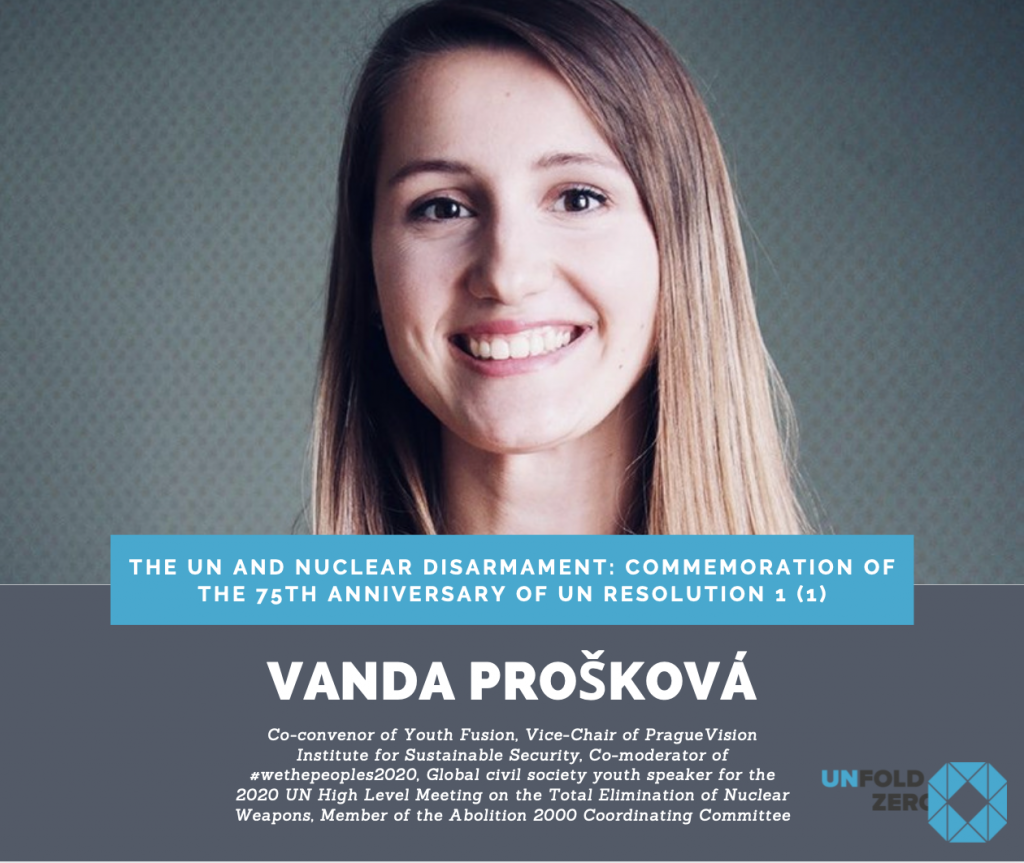
To commemorate the UN’s first ever Resolution, as the last speaker, Ms Proskova presented three global civil society appeals that were sent out on January 24th – 75 years on the day after the adoption of UNGA Resolution 1 (1). Together, the appeals urge heads of government, foreign ministers and UN member states’ ambassadors, to reduce the serious risks of nuclear weapons use (by accident, miscalculation or malevolent intent) and to act now to achieve the peace and security of a nuclear-weapon-free world. The appeals will be presented in forums such as the NPT Review Conference and the World Assembly of Parliaments. Read more about each appeal in detail here: Protect People and the Planet: Appeal for a Nuclear Weapon Free World; Abolish Nuclear Weapons to Assure a Sustainable Future; Time to Wrap up the Nuclear Weapons Era!
Ms Proskova encouraged all panelists and participants to check out the appeal statements and share them with their relevant networks, noting that “I think that pure information sharing is an efficient tool to help the cause.”
“A message to all the young enthusiasts in the audience: thank you for being here with us and for educating yourselves with us.”
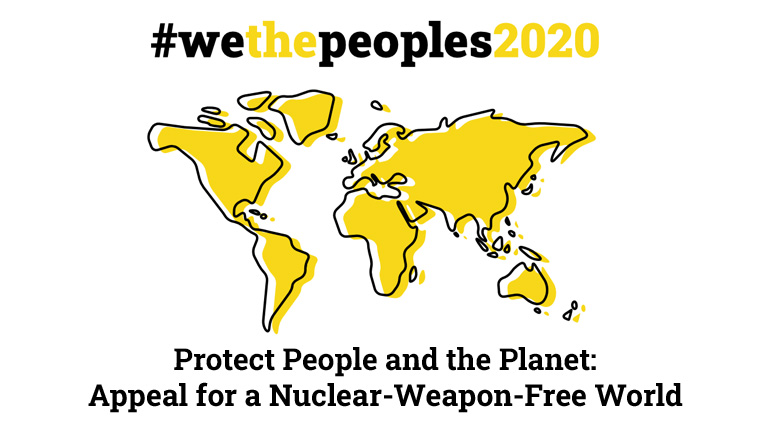
Session 2: Discussion
After the presentations, the panelists engaged in a fruitful discussion with the participants through answering six questions posed by the audience. The first questions related to issues of how to work directly with nuclear armed states towards disarmament, including: how to affect positive change in states with less democratic governance over security issues – including limits on civil society advocacy – such as China and Russia; what are the possibilities for renewed risk reduction and disarmament negotiations between the new US administration and Russia; and are multilateral approaches the best way forward to achieve disarmament, or could we ever hope to rely on unilateral action taken by nuclear armed states such as the US?
Dr Rydell commented that there is a significant addition of women in the top state department and national security council, all dealing with WMD issues. The new Under Secretary of State for Arms Control is an expert in and has long experience particularly in dealing with cooperative threat reduction mechanisms, stemming from agreements between the US and Russia in the 1990s seeking to reduce the risks of accidents, miscalculations and mal-use of nuclear weapons. “From both perspectives, having women in top positions in government and … also having expertise in the field of risk reduction is a very positive sign and something that I hope can be built upon.”
Ms Basu followed on from Dr Rydell noting that in addition to increasing the number of women in decision making, we also need young people to enter into these spaces given the extent to which so many youths today are more prone towards peace and disarmament steps than a lot of their seniors. “Getting more young people into parliament and recognising their expertise and unique viewpoints … would definitely help to ensure that the nuclear club tries to move away from nuclear weapons and ultimately achieve disarmament.”
“I am a stubborn optimist” Ms Espinosa went on, emphasising the importance of learning from history so as not to fall prey to an overbearing sense that actual positive change is impossible. “Nuclear weapons have proven to be so ineffective … to ensure peace and stability … and I think that we are living a moment in history where I see interest and appetite for transformation.” Ms Espinosa confirmed that she is a strong believer in multilateral solutions and the role of the UN, and despite growing polarisation and tensions in recent years she urged everyone to focus on the positives, such as the fact that so many are now actively talking about building back better and fairer from the pandemic, investing more in our commons, and bringing the concept of human security to the forefront of policy making.
“I think that human security should be considered a global commons, and a collective responsibility.” Ms Espinosa brought home her point through comparing the total annual budget spent on nuclear weapons globally (between 75 to 100 billion) and the total number directed to the entirety of UN activities amounting to a mere 3 billion dollars – including everything from peace, security, humanitarian relief, world health and dealing with the pandemic: figures that simply refutes common sense.
Moderator Alyn Ware added to Ms Espinosa’s comments through listing a range of examples of already existing initiatives as well as suggestions for individuals, parliamentarians and legislators, on how to move the nuclear weapons budgets away from continued nuclear investments, towards better use such as in public health spending, social services, the green transition, defence and arms industry conversion strategies, and so on.
Ms Proskova followed up on Ms Basu’s comments, arguing that the inclusion of youths into policy making has to come parallel to properly educating them in the issues of peace, nuclearism, disarmament and sustainability. “When holding roundtables, conferences or talks with Youth Fusion or Prague Vision, in 99,9% of the times we came to the conclusion that students of International Relations or Global Governance,or whatever field where you would expect that nuclear weapons are mentioned as part of their courses, they always tell us that … no one in their universities discusses these issues. [In whatever way we can now organise safely,] we need to get this information out there.”
“Education and awareness sharing is so essential, and this is something we need to be thinking about.”
A second round of questions touched upon how to build more engagement in common security and the use of international law to resolve conflicts rather than relying on the threat or use of force, including nuclear weapons. One question asked, if we cannot convince nuclear armed states to give up their nuclear weapons, could we convince them at least to resolve their conflicts through common security mechanisms, including the UN, and push them towards compliance with nuclear disarmament steps through law mechanisms, such the International Court of Justice, the International Criminal Court and various Human Rights bodies?
Dr Rydell noted that despite not being a lawyer, he has a great deal of respect for the use of law particularly regarding its usefulness in the disarmament field. To underscore this, he drew on the example of the legal goal of General and Complete Disarmament that can be found in twelve multilateral treaties, including Article 6 of the NPT. The concept comprises a combination of security tools largely taken from the UN Charter, and specifies both the elimination of WMD and the regulation of conventional arms. What is seldom touched upon, however, is the concept’s emphasis on the development of better mechanisms for the peaceful resolution of disputes including how to reduce the threat or use of force and redirect military spending to alternative sectors geared towards meeting basic human needs.
Dr Rydell then made the point that disarmament will only be achieved through drawing on this legal basis for non-violence in dispute resolution and through utilising, firstly, the rule of law (developing treaties, universal membership, compliance and verification methods) and secondly, democracy (including civil society and small, non-nuclear states in decision making) within disarmament frameworks. “Disarmament is very complex and involves a lot of progress across the board, not just in dealing with one or two weapons – but they all go on simultaneously and that is the beauty of it all. It is not like, first we must have peace and then we have disarmament – they both go hand in hand.”
Ms Espinosa echoed Dr Rydell in highlighting the significance of international law and “the importance of deploying what we have in hand.” In particular, she referred to the advisory opinion of the International Court of Justice from 1996 and the Human Rights Committee in 1984 and 2018, which together create an international legal framework denouncing the threat and use of nuclear weapons. “We cannot deny that we are living a trust deficit in our international organisations and young people know that very well, so to match international law and existing multilateral agreements on disarmament in action is of critical importance to bring back legitimacy and trust regarding our international institutions.”
“The worst thing that can happen is indifference, we can not be indifferent. … If the majority of society has the level of consciousness and commitment and speak up, I think that we will be much better off.”
Mr. Ware picked up on all the above points and highlighted the importance of raising awareness around all the positive examples of peaceful dispute settlement that have come true through the use of the International Court of Justice in the past decades – examples of good practice that are hardly ever mentioned neither in the news nor in peace and disarmament fora. “In order to help advance this common security, the use of international law and the confidence that this can help us resolve our differences without relying on the threat or use of force” Mr Ware suggested, “we need education about it.” This led Mr Ware on to the next and final question, regarding how to raise more awareness around this particular issue among youths?
Ms Basu agreed that the media overwhelmingly portray the negative aspects of nuclear disarmament and other global challenges, which increases people’s sensation of hopelessness whilst decreasing their belief in the ability of single individuals to create change. “Portraying the positive aspects and what has already been achieved, could definitely help lift their spirits and help people move forward. … In terms of education, that also plays a very big role.” Ms Basu’s own foundation, Green Hope, is doing just this through partnering with school boards and getting school children from numerous countries involved in conversations around disarmament.
“In places where there is still a taboo to talk about disarmament and nuclear weapons, I think it is better to start by implementing curriculum on the Sustainable Development Goals and use that as a medium to speak about all of the goals, including goal 16 on Peace, Justice and Strong Institutions, and thereby disarmament. … We can’t wait until children get to university to start educating them on all of these issues, it has to start from elementary school level.”
Ms Proskova followed on from Ms Basu, pointing out that the motto of the SDGs is to leave no one behind. “At Youth Fusion we are trying to highlight that you can’t really focus on climate change and forget about nuclear weapons, or you can’t really talk about gender equality and not mention the impact of nuclear weapons – or vice versa.” Through making the comparison of how much debts people across the world have to take on in order to receive a university education, to the numbers that are being spent on nuclear weapons and military institutions – the need for disarmament once again stands out as simply commonsensical.
The discussion ended on a celebration of intergenerational solidarity and the need for creating spaces for intergenerational dialogue and learning in everything from nuclear disarmament to peace and sustainability: so as to draw on existing tools but, importantly, to also update them whenever necessary.
The conclusion from the January 25th global event to commemorate UNGA Res 1(1) is thus, though the issues at hand are complex and many, the solution is one and simple – to act now and to act with resolution. Promoting nuclear disarmament is a question of taking action for future generations and, recalling Dr Rydell’s play on the words of Charles Dickens echoing back from another era eerily similar to today: “to make our times, the best of times.”
If you are interested in learning more about the activities of each organiser, check out the following websites: UNFOLD ZERO; Basel Peace Office; Parliamentarians for Nuclear Non-Proliferation and Disarmament; World Future Council; The Right Livelihood Foundation; Abolition 2000 Youth Network and Youth Fusion.
Following on from the discussion, also check out: Move the Nuclear Weapons Money; UN Human Rights Committee Comment Nr. 36 (2018); International Court of Justice Advisory Opinion on the Legality of the Threat or Use of Nuclear Weapons (1996).

